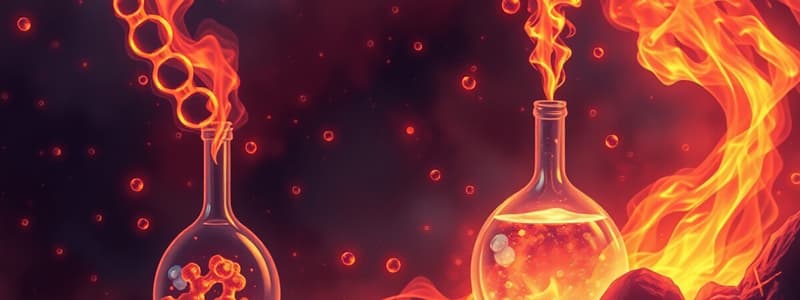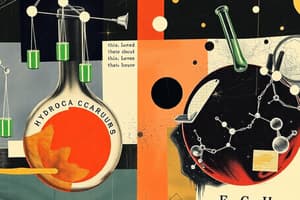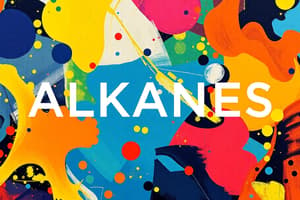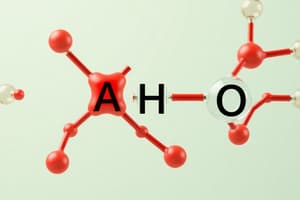Podcast
Questions and Answers
What process is used to produce alkanes from alkenes?
What process is used to produce alkanes from alkenes?
- Hydrogenation (correct)
- Hydrolysis
- Oxidation
- Dehydrogenation
Alkenes contain C-C single bonds.
Alkenes contain C-C single bonds.
False (B)
What catalyst is commonly used in the hydrogenation reaction to produce alkanes?
What catalyst is commonly used in the hydrogenation reaction to produce alkanes?
Finely divided Pt or Ni
Alkanes can be produced by cracking of longer ______.
Alkanes can be produced by cracking of longer ______.
Match the following terms related to alkanes with their descriptions:
Match the following terms related to alkanes with their descriptions:
What is produced during the complete combustion of alkanes?
What is produced during the complete combustion of alkanes?
Incomplete combustion occurs when there is an excess of oxygen.
Incomplete combustion occurs when there is an excess of oxygen.
What type of reaction forms halogenoalkanes from alkanes?
What type of reaction forms halogenoalkanes from alkanes?
Complete combustion of alkanes requires a ______ supply of oxygen.
Complete combustion of alkanes requires a ______ supply of oxygen.
Match the types of combustion with their characteristics:
Match the types of combustion with their characteristics:
What initiates the free-radical substitution reaction?
What initiates the free-radical substitution reaction?
The initiation step produces alkanes as final products.
The initiation step produces alkanes as final products.
What type of reaction explains how free radicals attack unreactive alkanes?
What type of reaction explains how free radicals attack unreactive alkanes?
In the propagation step, the free radicals can attack another __________ molecule.
In the propagation step, the free radicals can attack another __________ molecule.
Match the step of the free-radical substitution reaction with its description:
Match the step of the free-radical substitution reaction with its description:
Which statement about the free-radical substitution reaction is true?
Which statement about the free-radical substitution reaction is true?
The further substitution process results in the selective formation of a single halogenoalkane.
The further substitution process results in the selective formation of a single halogenoalkane.
What is produced after the alkyl free radical attacks a chlorine or bromine molecule?
What is produced after the alkyl free radical attacks a chlorine or bromine molecule?
What is the primary danger of carbon monoxide?
What is the primary danger of carbon monoxide?
Carbon monoxide has a distinct smell that helps in its detection.
Carbon monoxide has a distinct smell that helps in its detection.
What type of light is necessary for free-radical substitution of alkanes?
What type of light is necessary for free-radical substitution of alkanes?
The process of incomplete combustion often occurs in _____ due to limited oxygen.
The process of incomplete combustion often occurs in _____ due to limited oxygen.
Match the steps of the free-radical substitution mechanism with their descriptions:
Match the steps of the free-radical substitution mechanism with their descriptions:
During free-radical substitution, what happens in the initiation step?
During free-radical substitution, what happens in the initiation step?
The disappearance of bromine color during a reaction is an indication that no reaction has taken place.
The disappearance of bromine color during a reaction is an indication that no reaction has taken place.
What is the reason for the low reactivity of alkanes?
What is the reason for the low reactivity of alkanes?
What are the two halogens mentioned that can substitute hydrogen in alkanes?
What are the two halogens mentioned that can substitute hydrogen in alkanes?
Alkanes can react with polar reagents due to their polarity.
Alkanes can react with polar reagents due to their polarity.
What is the electronegativity difference between carbon and hydrogen in alkanes?
What is the electronegativity difference between carbon and hydrogen in alkanes?
Alkanes mainly undergo _____ reactions in chemical processes.
Alkanes mainly undergo _____ reactions in chemical processes.
Match the following terms with their correct definitions:
Match the following terms with their correct definitions:
Which of the following is a characteristic of alkanes?
Which of the following is a characteristic of alkanes?
Ethane is an example of a polar molecule.
Ethane is an example of a polar molecule.
What type of reactions do alkanes undergo with halogens?
What type of reactions do alkanes undergo with halogens?
What is the termination step in a free-radical substitution reaction?
What is the termination step in a free-radical substitution reaction?
The termination step of free-radical substitution always results in a pure halogenoalkane.
The termination step of free-radical substitution always results in a pure halogenoalkane.
What type of arrow is used to indicate the movement of one electron in free-radical mechanisms?
What type of arrow is used to indicate the movement of one electron in free-radical mechanisms?
The bond breaking in the initiation step is known as ___________ fission.
The bond breaking in the initiation step is known as ___________ fission.
Match the mechanism steps in free-radical substitution with their descriptions:
Match the mechanism steps in free-radical substitution with their descriptions:
Flashcards
Hydrogenation of Alkenes
Hydrogenation of Alkenes
A chemical reaction involving the addition of hydrogen to an alkene, resulting in the formation of an alkane. Usually takes place with a platinum or nickel catalyst.
Cracking of Alkanes
Cracking of Alkanes
Breaking down large alkane molecules into smaller alkanes and alkenes by applying heat and a catalyst.
Addition Reaction
Addition Reaction
A chemical reaction involving the addition of hydrogen to an alkene, resulting in the formation of an alkane.
Alkanes
Alkanes
Signup and view all the flashcards
Alkenes
Alkenes
Signup and view all the flashcards
Complete Combustion
Complete Combustion
Signup and view all the flashcards
Incomplete Combustion
Incomplete Combustion
Signup and view all the flashcards
Combustion of Alkanes
Combustion of Alkanes
Signup and view all the flashcards
Free Radical Substitution
Free Radical Substitution
Signup and view all the flashcards
Carbon monoxide poisoning
Carbon monoxide poisoning
Signup and view all the flashcards
Free-radical substitution in alkanes
Free-radical substitution in alkanes
Signup and view all the flashcards
Initiation step of free-radical substitution
Initiation step of free-radical substitution
Signup and view all the flashcards
Propagation step of free-radical substitution
Propagation step of free-radical substitution
Signup and view all the flashcards
Termination step of free-radical substitution
Termination step of free-radical substitution
Signup and view all the flashcards
The role of UV light in free-radical substitution
The role of UV light in free-radical substitution
Signup and view all the flashcards
The relationship of sunlight and bromine in free-radical substitution
The relationship of sunlight and bromine in free-radical substitution
Signup and view all the flashcards
Termination Step (Free Radical Substitution)
Termination Step (Free Radical Substitution)
Signup and view all the flashcards
Homolytic Fission
Homolytic Fission
Signup and view all the flashcards
Fish Hook Arrow
Fish Hook Arrow
Signup and view all the flashcards
Double-Headed Arrow
Double-Headed Arrow
Signup and view all the flashcards
Free-radical Initiation
Free-radical Initiation
Signup and view all the flashcards
Free-radical propagation
Free-radical propagation
Signup and view all the flashcards
Free-radical Further Substitution
Free-radical Further Substitution
Signup and view all the flashcards
Free Radicals
Free Radicals
Signup and view all the flashcards
Chain Reaction
Chain Reaction
Signup and view all the flashcards
Substitution Reaction
Substitution Reaction
Signup and view all the flashcards
Initiator
Initiator
Signup and view all the flashcards
Why are alkanes unreactive?
Why are alkanes unreactive?
Signup and view all the flashcards
How do alkanes lack polarity?
How do alkanes lack polarity?
Signup and view all the flashcards
Why don't alkanes react with polar reagents?
Why don't alkanes react with polar reagents?
Signup and view all the flashcards
How do nucleophiles and electrophiles relate to alkane reactivity?
How do nucleophiles and electrophiles relate to alkane reactivity?
Signup and view all the flashcards
What are the main reactions of alkanes?
What are the main reactions of alkanes?
Signup and view all the flashcards
How does ethane's structure explain its lack of polarity?
How does ethane's structure explain its lack of polarity?
Signup and view all the flashcards
What happens during combustion of alkanes?
What happens during combustion of alkanes?
Signup and view all the flashcards
What happens during halogen substitution of alkanes?
What happens during halogen substitution of alkanes?
Signup and view all the flashcards
Study Notes
Alkanes
- Alkanes are hydrocarbons containing only carbon-carbon single bonds and carbon-hydrogen single bonds
- They are saturated, meaning they have the maximum number of hydrogen atoms possible
- They are relatively unreactive due to the strong carbon-carbon and carbon-hydrogen bonds
- Alkanes are used as fuels because of their ability to combust releasing significant energy
Producing Alkanes
- Hydrogenation: Adding hydrogen to an alkene in the presence of a catalyst (like Pt/Ni) forms an alkane. This reaction is exothermic
- Cracking: Breaking down larger alkane molecules, found in crude oil, into smaller, more useful hydrocarbon molecules (alkanes and alkenes). This process requires high temperatures and catalysts. Cracking is endothermic
Combustion of Alkanes
- Complete Combustion: Occurs in the presence of excess oxygen, producing carbon dioxide and water.
- Incomplete Combustion: Occurs when there is a limited supply of oxygen, producing carbon monoxide and water, as well as some unburnt carbon. Carbon monoxide is a toxic gas, binding to haemoglobin which prevents it from binding oxygen.
Free Radical Substitution
- Alkanes can react with halogens (like chlorine or bromine) through a free radical substitution reaction
- This reaction only occurs in the presence of UV light, breaking the halogen molecule into free radical species which interact with the alkane forming new radicals which can continue the reaction with more halogen molecules. This is commonly used to change alkanes to halogenoalkanes to make useful compounds.
- The halogen-containing molecule and hydrogen gas will form. The initiation step is triggered by UV light which breaks the halogen molecule into single radicals which cause the chain reaction. The propagation steps show how the radicals repeat. Termination steps show how the reaction stops, with two radicals forming stable molecules.
Chemical Reactivity of Alkanes
- The carbon-hydrogen and carbon-carbon bonds in alkanes are very strong and difficult to break.
- The almost equal electronegativities of carbon and hydrogen in an alkane mean the molecules are non-polar.
- Due to their unreactivity, alkanes mainly undergo combustion reactions or free radical substitution reactions when exposed to high energy.
Obtaining Useful Compounds by Cracking
- Crude oil is a complex mixture of hydrocarbons.
- Fractional distillation separates crude oil into fractions based on their boiling points. Each fraction contains a range of alkanes with similar boiling points.
- Cracking breaks down large hydrocarbon molecules into smaller, more useful ones, like alkenes and alkanes, with simpler structures and lower boiling points, suitable for various purposes (e.g., gasoline).
- Cracking typically is done by heating hydrocarbon molecules in the presence of a catalyst to cause them to break into smaller fragments.
Studying That Suits You
Use AI to generate personalized quizzes and flashcards to suit your learning preferences.




